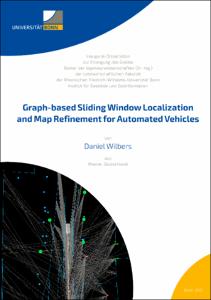Wilbers, Daniel: Graph-based Sliding Window Localization and Map Refinement for Automated Vehicles. - Bonn, 2021. - Dissertation, Rheinische Friedrich-Wilhelms-Universität Bonn.
Online-Ausgabe in bonndoc: https://nbn-resolving.org/urn:nbn:de:hbz:5-64032
Online-Ausgabe in bonndoc: https://nbn-resolving.org/urn:nbn:de:hbz:5-64032
@phdthesis{handle:20.500.11811/9352,
urn: https://nbn-resolving.org/urn:nbn:de:hbz:5-64032,
author = {{Daniel Wilbers}},
title = {Graph-based Sliding Window Localization and Map Refinement for Automated Vehicles},
school = {Rheinische Friedrich-Wilhelms-Universität Bonn},
year = 2021,
month = oct,
note = {Localization is an essential task in automated driving and advanced driver assistance systems. The precise location of a vehicle is required for extracting information from a map about the vehicle's environment. The map information is typically used to enrich the perceptions of the vehicle using its sensors to ease tasks such as scene understanding or planning. This thesis investigates the challenge of creating a localization framework for automated driving in urban scenarios. Our localization approach relies on detecting distinct elements, so-called landmarks, in the vehicle's surroundings and aligning them to a given map to infer the vehicle's location. A particular challenge that we investigate is using general-purpose landmark maps from third-party distributors for localization. These maps are typically not tailored towards a specific sensor setup or the vehicle's direct sensor configuration, such that the third-party map is not tuned to what the vehicle is able to detect. We explicitly consider this challenge within our approach. In return, our approach allows for using landmark detections from different sensors with a single general-purpose map for localization. Another fundamental challenge of map-based approaches is that maps are getting outdated over time, which is a safety-critical aspect of localization for automated driving. Therefore, it is necessary to establish a reliable update process for successful long-term operation. We contribute to that goal by computing map update hypotheses during operation that could be transmitted to a server back-end for fleet-based validation. We solve localization and map refinement in a combined approach that uses graph-based sliding window optimization to estimate the vehicle's trajectory and landmark positions in an accurate and computationally efficient way. We describe how to construct our approach as a factor graph and derive its necessary factors to model the map landmarks as a prior over the landmark detections. Our approach fuses landmark detections from various sensors, e.g., LiDAR and camera, together with odometry and GNSS measurements. Additionally, we present how to compute sparse global priors, a novel sparsification scheme that allows us to preserve information that we remove from our sliding window without the drawbacks of dense marginalization. We thoroughly evaluate our approach based on real-world data and trajectories recorded in an automated vehicle.},
url = {https://hdl.handle.net/20.500.11811/9352}
}
urn: https://nbn-resolving.org/urn:nbn:de:hbz:5-64032,
author = {{Daniel Wilbers}},
title = {Graph-based Sliding Window Localization and Map Refinement for Automated Vehicles},
school = {Rheinische Friedrich-Wilhelms-Universität Bonn},
year = 2021,
month = oct,
note = {Localization is an essential task in automated driving and advanced driver assistance systems. The precise location of a vehicle is required for extracting information from a map about the vehicle's environment. The map information is typically used to enrich the perceptions of the vehicle using its sensors to ease tasks such as scene understanding or planning. This thesis investigates the challenge of creating a localization framework for automated driving in urban scenarios. Our localization approach relies on detecting distinct elements, so-called landmarks, in the vehicle's surroundings and aligning them to a given map to infer the vehicle's location. A particular challenge that we investigate is using general-purpose landmark maps from third-party distributors for localization. These maps are typically not tailored towards a specific sensor setup or the vehicle's direct sensor configuration, such that the third-party map is not tuned to what the vehicle is able to detect. We explicitly consider this challenge within our approach. In return, our approach allows for using landmark detections from different sensors with a single general-purpose map for localization. Another fundamental challenge of map-based approaches is that maps are getting outdated over time, which is a safety-critical aspect of localization for automated driving. Therefore, it is necessary to establish a reliable update process for successful long-term operation. We contribute to that goal by computing map update hypotheses during operation that could be transmitted to a server back-end for fleet-based validation. We solve localization and map refinement in a combined approach that uses graph-based sliding window optimization to estimate the vehicle's trajectory and landmark positions in an accurate and computationally efficient way. We describe how to construct our approach as a factor graph and derive its necessary factors to model the map landmarks as a prior over the landmark detections. Our approach fuses landmark detections from various sensors, e.g., LiDAR and camera, together with odometry and GNSS measurements. Additionally, we present how to compute sparse global priors, a novel sparsification scheme that allows us to preserve information that we remove from our sliding window without the drawbacks of dense marginalization. We thoroughly evaluate our approach based on real-world data and trajectories recorded in an automated vehicle.},
url = {https://hdl.handle.net/20.500.11811/9352}
}






